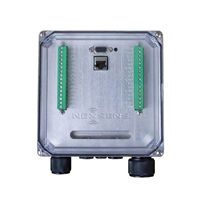 Though there are many data buoys floating around Lake Michigan, many of these are deployed in nearshore areas. There are still many offshore regions where scientists lack direct data from which to draw conclusions. One of these spaces is the stretch of water between Charlevoix, Michigan and Beaver Island, a popular destination for tourists. Luckily for researchers at Central Michigan University, the Emerald Isle ferry makes several trips to the island each day.
Though there are many data buoys floating around Lake Michigan, many of these are deployed in nearshore areas. There are still many offshore regions where scientists lack direct data from which to draw conclusions. One of these spaces is the stretch of water between Charlevoix, Michigan and Beaver Island, a popular destination for tourists. Luckily for researchers at Central Michigan University, the Emerald Isle ferry makes several trips to the island each day.
Investigators at the university’s Institute for Great Lakes Research have capitalized on the Emerald Isle ferry’s route by installing water quality monitoring equipment in the ship’s hull. By partnering with the Beaver Island Boat Company that owns the ferry, they were able to save a great amount of money on the cost of operating a research vessel.
Selecting the right equipment
The scientists worked with NexSens Technology to obtain the gear needed for the system, including internet-connected data logging equipment and web datacenter services. NexSens engineers also assisted with setting up the system and training Central Michigan University staff to run it on their own. The gear now operating in the ferry’s hull are logging measurements on a great many Lake Michigan parameters, cluing in researchers near and far to its changing aquatic health.
In the hull of the Emerald Island ferry, project managers have built a custom enclosure marked with a Central Michigan University logo. This serves to mark and protect the system within, which circulates Lake Michigan water through a Teledyne ISCO sampler that collects discrete samples at project-defined intervals.
Results may “ferry”

Next to this sampler is a YSI EXO2 Multi-Parameter Water Quality Sonde that tracks Lake Michigan conditions while deployed in a flow cell that permits the lake’s water to pass through. This sonde carries sensors for measuring significant parameters including conductivity, temperature, pH, oxidation-reduction potential, optical dissolved oxygen, turbidity, total algae and fluorescent dissolved organic matter. A central wiper cleans off sensor faces at a predetermined interval to fight biofouling and ensure continuously reliable sensor performance.
Data from the sonde, as well as positional information provided by a Garmin GPS 19x HVS High Sensitivity Receiver, are recorded by a NexSens 5100-OEM Data Logger. This Ethernet-equipped logger connects directly to the internet and pushes data to a NexSens WQData LIVE Web Datacenter where they are accessible by other Great Lakes scientists and the general public.
Images courtesy of Central Michigan University
The YSI EXO represents the next generation of water quality instruments from YSI. The EXO2 sonde includes six sensor ports and a central anti-fouling wiper option.
The rugged GPS 19x NMEA 0183 receiver/antenna offers high sensitivity reception and pinpoint GPS accuracy.
The NexSens iSIC V2 Environmental Data Logger offers the latest in real-time monitoring technology with wireless communication, large plug-and-play sensor library, and ultra-low power consumption.
WQData LIVE is a web-based project management service that allows users 24/7 instant access to data collected from remote telemetry systems.




